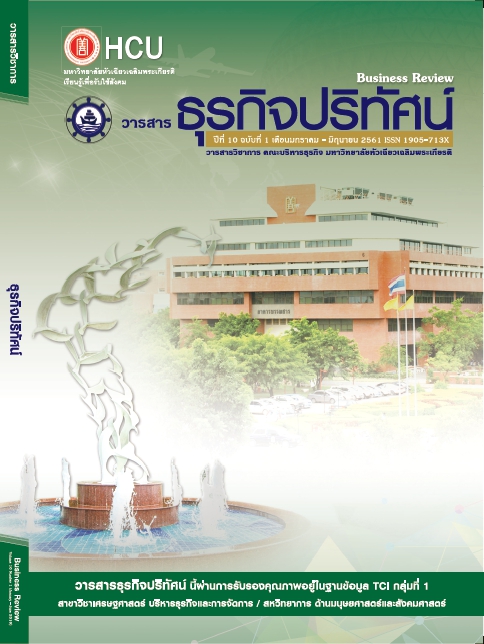Insight of Public Civil Servants: Public Service Motivation and Benefit
Keywords:
Public Service, Benefits, Civil Servants, MotivationAbstract
This is a qualitative research aims to explain an insight or a reason to work as a
civil servant and to study a perception of Public Service Motivation and an importance of
benefits in an organization on a decision to be a civil servant. An in-depth interview with
20 civil servants work as a Government Office was employed.
The results of this study showed that eight civil servants are served in the public
service because of the Public Service Motivation. They showed public interest through the
following dimensions which are 1) attraction to public policy formation, 2) commitment to
public interest, 3) compassion, 4) self-sacrifice. All were reflected as intentions to be a civil
servant. These conform to the mission of government that focuses in servicing the needs of
people. The twelve servants are motivated to serve in the Public Service with four main
reasons 1) concerning on the benefits and advantages for themselves and family, 2) the
more security life after retirement, 3) reducing costs of living, and 4) a moral for civil
servant job. In addition, the main reason is related with a security of living.
References
ดำเนินงานของสถานีตำรวจเพื่อประชาชน (วิทยานิพนธ์ปรัชญาดุษฎีบัณฑิต). มหาวิทยาลัย
สงขลานครินทร์, คณะวิทยาการจัดการ.
กิ่งพร ทองใบ. (2553). ระบบค่าตอบแทนสมัยใหม่ จากวิชาการสู่วิชาชีพ. กรุงเทพฯ: พิมพ์ดีการพิมพ์.
ชาย โพธิศิตา. (2552). ศาสตร์และศิลป์แห่งการวิจัยเชิงคุณภาพ. กรุงเทพฯ: อัมรินทร์พริ้นติ้งแอนพับลิชชิ่ง.
นัทที ขจรกิตติยา. (2554). ปัจจัยเชิงสาเหตุและผลของแรงจูงใจในการบริการสาธารณะในสามจังหวัด
ชายแดน ภาคใต้ของไทย: การทบทวนวรรณกรรม. การประชุมวิชาการเสนอผลงานวิจัยระดับ
บัณฑิตศึกษาแห่งชาติ, 23, 684-690.
บุณยฤทธิ์ พร้อมสุทธิพงศ์. (2556). บทบาทของคริสตจักรในจังหวัดเชียงใหม่ในการสร้างแรงจูงใจสาธารณะ.
(วิทยานิพนธ์มหาบัณฑิต). มหาวิทยาลัยเชียงใหม่, คณะรัฐศาสตร์และรัฐประศาสนศาสตร์.
ประชาชาติธุรกิจ. (2555). แห่สมัครข้าราชการนับล้าน รับแค่ 6 พัน สรรพากร กรมการปกครองและ
กระทรวงเกษตรฯรับมากที่สุด. สืบค้นเมื่อวันที่ 18 กุมภาพันธ์ 2559. เว็ปไซด์ http://
www.kruthai.info/view.php?article_id=1110
ปรียานุช วัฒนกูล. (2550). ค่านิยมในการรับราชการของข้าราชการยุคใหม่นาบริบทของความ
เปลี่ยนแปลง.สืบค้นเมื่อวันที่ 20 กุมภาพันธ์ 2559.เว็ปไซด์ http://www.ocsc.go.th /ocsc /th/
files/BRD_Reserch/thesis%20knowledge/11_Jan_2013/4_2550.pdf
มูลนิธิสถาบันอนาคตไทยศึกษา. (2015). ข้อเท็จจริง 10 ปี ระบบข้าราชการไทย. สืบค้นเมื่อวันที่ 20
กุมภาพันธ์ 2559. เว็ปไซด์ http://www.thailandff.org/upload/reports/10%20year%20gov
_officer.pdf
รุจี อมฤตย์, ปฐม มณีโรจน์, ภาคภูมิ ฤกขะเมธ และ รัชนีกูล ภิญโญภานุวัฒน์. (2557). การศึกษา
พฤติกรรมการเป็นสมาชิกที่ดีขององค์การภาครัฐไทย: ศึกษากรณีข้าราชการในมหาวิทยาลัย
ของรัฐ เขตกรุงเทพฯและปริมณฑล. วารสารการจัดการสมัยใหม่, 12(2), 38-55
วรรณดี สุทธินรากร. (2556). การวิจัยเชิงคุณภาพ: การวิจัยในกระบวนทัศน์ทางเลือก. กรุงเทพฯ: ศยาม.
วรรษพร อากาศแจ้ง.(2556). ปัจจัยที่ส่งผลต่อความตั้งใจลาออกของคนเก่งในระบบราชการ. WMS
Journal of Manangement Walailak University. 2(2), 47-58.
ศุภชัย ยาวะประภาษ. (2548). การบริหารงานบุคคลภาครัฐไทย:กระแสใหม่และสิ่งท้าทาย. กรุงเทพฯ:
บริษัท จุดทอง จำกัด.
สำนักพัฒนาระบบจำแนกตำแหน่งและค่าตอบแทน สำนักงาน ก.พ.. (2557). มาตรการบริหารและ
พัฒนากำลังคนภาครัฐ (พ.ศ. 2557-2561) และแนวปฏิบัติ. กรุงเทพฯ: บริษัท 21 เซ็นจูรี่ จำกัด
สุรางค์รัตน์ วศินารมย์. (2540). สวัสดิการในองค์กร: แนวคิดและวิธีการการบริหาร. กรุงเทพฯ:
เม็ดทราย พริ้นติ้ง.
A.B. Shani, Dawn Chandler, Jean-Francois Coget and James B. Lau. (2009). Behavior in
Organization: An Experiential Approach. New York: McGrew-Hill.
Betty Yung. (2014). Differential Public Service Motivation Among Hong Kong Public Officials:
A Qualitative Study. Public Personnel Management, 43(4), 415-441.
Emanuel Camilleri, (2007). Antecedent affecting public service motivation. Personnel Review,
36(3), 356-377.
Greenberg, Jerald and Baron, A. Robert. (2008). Behavior in Organization: Understanding and
Managing the Human Side of work. 8thed. New Jersey: Prentice Hall.
James L. Perry and Lois Recasino Wise. (1990). The Motivational Bases of Public Service. Public
Administration Review, 50(3), 367-373.
James L. Perry. (1996). Measuring Public Service Motivation: An Assessment of Construct
Reliability and Validity. Journal of Public Administration Research and Theory, 6(1), 5-22
James L.Perry, Annie Hondeghem and Lois Recascino Wise. (2010). Revisiting the Motivational
Bases of Public Service: Twenty Year of Research and an Agenda for the Future. Public
Administration Review, 70(5),681-690.
Michael Armstrong and Henlen Murlis. (2007). Reward Management: A Handbook of
Remuneration Strategy and Practice. 5 thed. London: Kogan Page 2001.
Neal Chalofsky and Vijay Krishna. (2009). Meaningfulness, Commitment, and Engagement: The
Intersection of a Deeper Level of Intrinsic Motivation. Advances in Developing Human
Resources, 11(2), 189-203.
Sangmook Kim. (2006). Public service motivation and organizational citizenship behavior in
Korea. International Journal of Manpower, 27(8),722-740.
Virginia Braun and Victoria Clarke. (2006). Using thematic analysis in psychology. Qualitative
Research in Psychology, 3, (77-101)
Wouter Vandenabeele, (2011). Who Want to Deliver Public Service? Do Institutional Antecedents
of Public Service Motivation Provide an Answer?. Review of Public Personnel
Administration, 31(1).87-107
Downloads
Published
How to Cite
Issue
Section
License
All articles published in the Business Administration and Management Journal Review are copyrighted by the journal.
The views and opinions expressed in each article are solely those of the individual authors and do not represent those of Huachiew Chalermprakiet University or any other faculty members. Each author is fully responsible for the content of their own article. Any errors or issues found are the sole responsibility of the respective author.




